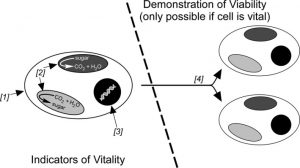Regulations for ballast water remedy specify limits on the concentrations of dwelling cells in discharge water. The very important stains fluorescein diacetate (FDA) and 5-chloromethylfluorescein diacetate (CMFDA) together have been beneficial to be used in verification of ballast water remedy know-how. We examined the effectiveness of FDA and CMFDA, singly and together, in discriminating between dwelling and heat-killed populations of 24 species of phytoplankton from seven divisions, verifying with quantitative progress assays that uniformly dwell and lifeless populations had been in contrast. The diagnostic sign, per-cell fluorescence depth, was measured by stream cytometry and alternate discriminatory thresholds had been outlined statistically from the frequency distributions of the lifeless or dwelling cells.
Species had been clustered by staining patterns: for 4 species, the staining of dwell versus lifeless cells was distinct, and live-dead classification was primarily error free. But overlap between the frequency distributions of dwelling and heat-killed cells within the different taxa led to unavoidable errors, nicely in extra of 20% in lots of. In Four very weakly staining taxa, the imply fluorescence depth within the heat-killed cells was larger than that of the dwelling cells, which is inconsistent with the assumptions of the strategy. Applying the standards of ≤5% false destructive plus ≤5% false constructive errors, and no important lack of cells resulting from staining, FDA and FDA+CMFDA gave acceptably correct outcomes for under 8-10 of 24 species (i.e., 33%-42%). CMFDA was the least efficient stain and its addition to FDA didn’t enhance the efficiency of FDA alone.

Classification of phytoplankton cells as live or dead using the vital stains fluorescein diacetate and 5-chloromethylfluorescein diacetate.
Design and synthesis of a luminescent cyclometalated iridium(III) advanced having N,N-diethylamino group that stains acidic intracellular organelles and induces celldemise by photoirradiation.
Cyclometalated iridium(III) complexes have obtained appreciable consideration and are essential candidates to be used as luminescent probes for mobile imaging due to their potential photophysical properties. We beforehand reported that fac-Ir(atpy)(3)4 (atpy = 2-(5′-amino-4′-tolyl)pyridine) containing three amino teams on the 5′-position of the atpy ligand exhibits a most purple emission (at round 600 nm) underneath impartial and fundamental situations and a inexperienced emission (at 531 nm) at acidic pH (pH 3-4). In this Article, we report on the design and synthesis of a brand new pH-sensitive cyclometalated Ir(III) advanced containing a 2-(5′-N,N-diethylamino-4′-tolyl)pyridine (deatpy) ligand, fac-Ir(deatpy)(3)5.
The advanced displays a substantial change in emission depth between impartial and barely acidic pH (pH 6.5-7.4). Luminescence microscopic research utilizing HeLa-S3 cells point out that 5 can be utilized to selectively stain lysosome, an acidic organelle in cells. Moreover, advanced 5 is able to producing singlet oxygen in a pH-dependent method and inducing the demise of HeLa-S3 cells upon photoirradiation at 377 or 470 nm.
Curious outcomes with palladium- and platinum-carrying polymers in mass cytometry bioassays and an surprising utility as a lifeless cell stain.
We describe the synthesis of metal-chelating polymers (MCPs) with 4 completely different pendant polyaminocarboxylate ligands (EDTA, DTPA, TTHA, DOTA) and an orthogonal end-group, both a fluorescein molecule or a bismaleimide linker for antibody attachment. Polymer characterization by a mix of (1)H NMR, UV/vis absorption measurements, and thermal gravimetric evaluation (TGA) indicated that every chain of the fluorescein-terminated polymers contained one dye molecule.
[Linking template=”default” type=”products” search=”fluorescein FITC” header=”4″ limit=”136″ start=”3″ showCatalogNumber=”true” showSize=”true” showSupplier=”true” showPrice=”true” showDescription=”true” showAdditionalInformation=”true” showImage=”true” showSchemaMarkup=”true” imageWidth=”” imageHeight=””]
These polymer samples had been loaded with three several types of lanthanide ions in addition to palladium and platinum ions. The numbers of metallic atoms per chain had been decided by a mix of UV/vis and standard ICP-MS measurements. The experiments with lanthanide ions demonstrated {that a} web anionic cost on the polymer is essential for water solubility. These experiments additionally confirmed that no less than one kind of lanthanide ion (La(3+)) is able to forming a bimetallic advanced with pendant DTPA teams.
